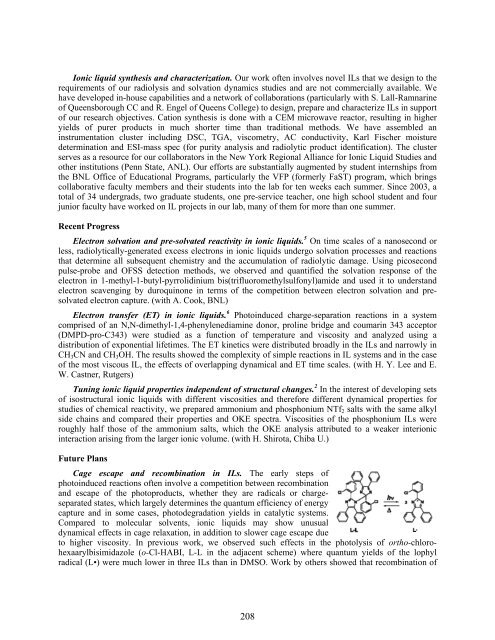Eighth Condensed Phase and Interfacial Molecular Science (CPIMS)
Eighth Condensed Phase and Interfacial Molecular Science (CPIMS)
Eighth Condensed Phase and Interfacial Molecular Science (CPIMS)
You also want an ePaper? Increase the reach of your titles
YUMPU automatically turns print PDFs into web optimized ePapers that Google loves.
Ionic liquid synthesis <strong>and</strong> characterization. Our work often involves novel ILs that we design to the<br />
requirements of our radiolysis <strong>and</strong> solvation dynamics studies <strong>and</strong> are not commercially available. We<br />
have developed in-house capabilities <strong>and</strong> a network of collaborations (particularly with S. Lall-Ramnarine<br />
of Queensborough CC <strong>and</strong> R. Engel of Queens College) to design, prepare <strong>and</strong> characterize ILs in support<br />
of our research objectives. Cation synthesis is done with a CEM microwave reactor, resulting in higher<br />
yields of purer products in much shorter time than traditional methods. We have assembled an<br />
instrumentation cluster including DSC, TGA, viscometry, AC conductivity, Karl Fischer moisture<br />
determination <strong>and</strong> ESI-mass spec (for purity analysis <strong>and</strong> radiolytic product identification). The cluster<br />
serves as a resource for our collaborators in the New York Regional Alliance for Ionic Liquid Studies <strong>and</strong><br />
other institutions (Penn State, ANL). Our efforts are substantially augmented by student internships from<br />
the BNL Office of Educational Programs, particularly the VFP (formerly FaST) program, which brings<br />
collaborative faculty members <strong>and</strong> their students into the lab for ten weeks each summer. Since 2003, a<br />
total of 34 undergrads, two graduate students, one pre-service teacher, one high school student <strong>and</strong> four<br />
junior faculty have worked on IL projects in our lab, many of them for more than one summer.<br />
Recent Progress<br />
Electron solvation <strong>and</strong> pre-solvated reactivity in ionic liquids. 5 On time scales of a nanosecond or<br />
less, radiolytically-generated excess electrons in ionic liquids undergo solvation processes <strong>and</strong> reactions<br />
that determine all subsequent chemistry <strong>and</strong> the accumulation of radiolytic damage. Using picosecond<br />
pulse-probe <strong>and</strong> OFSS detection methods, we observed <strong>and</strong> quantified the solvation response of the<br />
electron in 1-methyl-1-butyl-pyrrolidinium bis(trifluoromethylsulfonyl)amide <strong>and</strong> used it to underst<strong>and</strong><br />
electron scavenging by duroquinone in terms of the competition between electron solvation <strong>and</strong> presolvated<br />
electron capture. (with A. Cook, BNL)<br />
Electron transfer (ET) in ionic liquids. 6 Photoinduced charge-separation reactions in a system<br />
comprised of an N,N-dimethyl-1,4-phenylenediamine donor, proline bridge <strong>and</strong> coumarin 343 acceptor<br />
(DMPD-pro-C343) were studied as a function of temperature <strong>and</strong> viscosity <strong>and</strong> analyzed using a<br />
distribution of exponential lifetimes. The ET kinetics were distributed broadly in the ILs <strong>and</strong> narrowly in<br />
CH3CN <strong>and</strong> CH3OH. The results showed the complexity of simple reactions in IL systems <strong>and</strong> in the case<br />
of the most viscous IL, the effects of overlapping dynamical <strong>and</strong> ET time scales. (with H. Y. Lee <strong>and</strong> E.<br />
W. Castner, Rutgers)<br />
Tuning ionic liquid properties independent of structural changes. 2 In the interest of developing sets<br />
of isostructural ionic liquids with different viscosities <strong>and</strong> therefore different dynamical properties for<br />
studies of chemical reactivity, we prepared ammonium <strong>and</strong> phosphonium NTf2 salts with the same alkyl<br />
side chains <strong>and</strong> compared their properties <strong>and</strong> OKE spectra. Viscosities of the phosphonium ILs were<br />
roughly half those of the ammonium salts, which the OKE analysis attributed to a weaker interionic<br />
interaction arising from the larger ionic volume. (with H. Shirota, Chiba U.)<br />
Future Plans<br />
Cage escape <strong>and</strong> recombination in ILs. The early steps of<br />
photoinduced reactions often involve a competition between recombination<br />
<strong>and</strong> escape of the photoproducts, whether they are radicals or chargeseparated<br />
states, which largely determines the quantum efficiency of energy<br />
capture <strong>and</strong> in some cases, photodegradation yields in catalytic systems.<br />
Compared to molecular solvents, ionic liquids may show unusual<br />
dynamical effects in cage relaxation, in addition to slower cage escape due<br />
to higher viscosity. In previous work, we observed such effects in the photolysis of ortho-chlorohexaarylbisimidazole<br />
(o-Cl-HABI, L-L in the adjacent scheme) where quantum yields of the lophyl<br />
radical (L•) were much lower in three ILs than in DMSO. Work by others showed that recombination of<br />
208
















